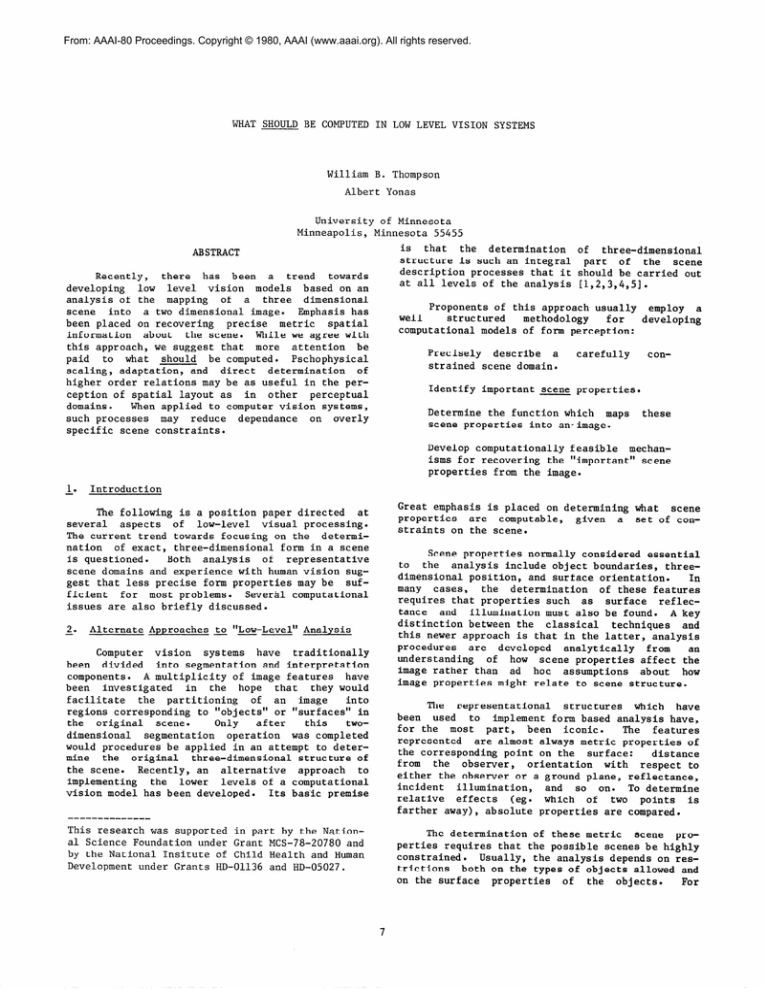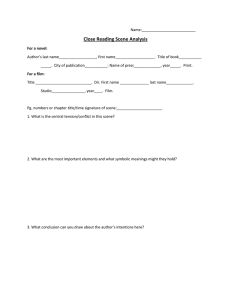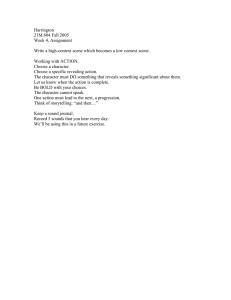
From: AAAI-80 Proceedings. Copyright © 1980, AAAI (www.aaai.org). All rights reserved.
WHAT
SHOULD
BE COMPUTED
William
IN LOW LEVEL
VISION
SYSTEMS
B. Thompson
Albert
Yonas
University of Minnesota
Minneapolis,
Minnesota 55455
ABSTRACT
there
has been
a trend
towards
Recently,
developing
low
level
vision
models
based on an
of a three
dimensional
analysis of the mapping
Emphasis has
scene
into
a two dimensional
image.
been placed on recovering
precise
metric
spatial
While we agree with
the scene.
about
information
attention
be
this approach, we suggest that more
should
be computed.
Pschophysical
paid
to what
direct
determination
of
scaling, adaptation, and
higher order relations may be as useful in the perperceptual
ception of spatial layout as
in other
domains.
When applied to computer vision systems,
reduce
dependance
on overly
such processes
may
specific scene constraints.
is that
the determination
of
three-dimensional
structure is such an integral
part
of
the
scene
description processes that it should be carried out
at all levels of the analysis [1,2,3,4,51.
Proponents of this approach usually
well
structured
methodology
for
computational models of form perception:
Precisely
describe
a
strained scene domain.
carefully
Identify
properties.
important
scene
Determine the function which
maps
scene properties into an-image.
employ
a
developing
con-
these
Develop computationally
feasible
mechanisms for recovering the "important" scene
properties from the image.
L*
Introduction
The following is a position paper directed
at
of
low-level
visual processing.
several
aspects
The current trend towards focusing on the determiform in a scene
nation
of exact, three-dimensional
Both
analysis
of
representative
is questioned.
scene domains and experience with human vision suggest that less precise form properties may be
sufSeveral computational
ficient
for most problems.
issues are also briefly discussed.
2.
Alternate
Approaches
-to "Low-Level"
--
Analysis
Computer
vision
systems
have
traditionally
into segmentation
and interpretation
been
divided
components.
A multiplicity
of image features
have
they would
investigated
in the hope
that
been
into
image
the partitioning
of an
facilitate
regions corresponding
to "objects" or "surfaces" in
after
this
twoscene.
the
original
Only
operation
was completed
dimensional
segmentation
would procedures be applied in an attempt to deterthe original
mine
three-dimensional
structure of
the scene.
Recently, an alternative
approach
to
implementing
the lower
levels of a computational
Its basic premise
vision model has been developed.
This research was supported in part by the National Science Foundation under Grant MCS-78-20780
and
by the National Insitute of Child Health and Human
Development under Grants HD-01136 and HD-05027.
Great emphasis is placed on determining
properties
are
computable,
given
a
straints on the scene.
what
scene
set of con-
Scene properties normally considered essential
to the analysis include object boundaries,
threedimensional position, and surface orientation.
In
many
cases,
the determination
of these features
requires that properties such
as surface
reflectance
and
illumination must also be found.
A key
distinction between the classical
techniques
and
this newer approach is that in the latter, analysis
procedures
are
developed
analytically
from
an
understanding
of how
scene properties affect the
image rather than
ad hoc
assumptions
about
how
image properties might relate to scene structure.
The
representational
structures
which
have
been
used
to implement form based analysis have,
for the most
part,
been
iconic.
The
features
represented
are almost always metric properties of
the corresponding
point on the
surface:
distance
from
the observer,
orientation
with
respect to
either the observer or a ground plane, reflectance,
incident
illumination,
and
so on.
To determine
relative
effects
(eg. which
of
two points
is
farther away), absolute properties are compared.
The determination
of these metric
scene
properties requires that the possible scenes be highly
constrained.
Usually, the analysis depends on restrictions
both on the types of objects allowed and
on the surface
properties
of
the
objects.
For
soid with semi-axes A, B, and C.
(A was
in
the
horizontal
direction
as seen by the viewer, B was
in the vertical direction, and C was in the direction
along
the
line
of sight.)
The object was
presented against a black background,
and
thus
no
cast
shadows
were present.
In one set of experiments, A and B were held constant producing a circular
occluding
contour.
Subjects were asked to
estimate the value of C for a number
of different
displays,
with
true
values of C ranging from one
half of A to four times A. On initial trials, subjects tended to see the same shape independently
of
the actual value of C. On subsequent trials,
performance
improved,
but
with
a significant,
systematic underestimation
of the true value.
As
a
final
note,
when
subjects were asked to qualitatively describe the changes in the scene as
C was
varied,
they
often
indicated that they felt that
the change was due to differences
in illumination,
not shape.
example,
a "blocks
world"
assumption
(or alternately, the assumption of a "Play-Doh"
world
made
entirely
of smooth
surfaces)
might be made.
In
addition, it is commonly assumed that surfaces
are
all
lambertian
reflectors
and
that, for a given
surface,
the
coefficient
of
reflectance
is
constant.
Illumination
is often limited to a single distant point source, possibly coupled
with
a
diffuse
illuminator.
Secondary
illumination
effects are usually presumed to be negligible.
20
Absolute
Scene
Properties
Are Not Always
-m
Needed
The proponents of form based analysis
presume
the need
for
finding exact shape properties of a
scene.
They concentrate on investigating
how
constraints
on scenes affect what properties are computable and how they can be determined.
We suggest
that more attention be paid towards what properties
should be computed.
We
argue
that
for
a wide
variety
of problem areas, absolute metric information about scene shape is not
required.
Instead,
relative
properties
such
as
flat/curved,
convex/concave,
farther-away/closer,
etc. are
both
sufficient and easier to compute.
It is certainly premature to make any
definitive
conclussions
from our results.
Nevertheless,
we
suggest
the following
conjecture:
Subjects
appear
to see a specific shape (as opposed to simproperply a "round" object); however, the metric
ties
they
estimate
for that shape are not necessarily consistent with the "true" values.
The subjects
do appear
to be better at ranking displays
based on different values of C.
Most tasks involving description of a visual
environment depend on generalized
shape properties.
In fact, much effort has been spent
searching
for
shape characterizations
that embody those relationships useful for description but not
the
enormous
amount
of
irrelevant
detail
contained
in any
representation
based on specific position.
Even in
task domains such as object manipulation
and obstacle avoidance, precise
positional
information
is
frequently
not
necessary.
Both these task areas
contain significant sub-problems
involving
object
identification
- a descriptive
task often possible
with approximate and/or relative information
about
shape.
Even when actual position is needed, feedback control can be used to minimize the need
for
highly accurate positional determinations.
4*
Non-metric
---
Scene
Properties
We suggest that requiring
specific,
accurate
determination
of scene properties may be unnecessarily restrictive.
Less
precise
and/or
purely
relative
qualities
are sufficient for many situations.
By concentrating
on these
characteristics,
we may
be
able
to significantly
relax the constraints
under
which
our
computational
vision
models
must
operate.
Finally,
human
vision is
often quite inaccurate in determining metric values
for
these same properties.
Rather than indicating
a deficiency in human vision,
this
suggests
that
alternative
(and
presumably
more useful) characteristics are being
computed
by
the human
perceiver.
A second argument for emphasizing
the difficulty
of determining metric properties comes from
our experience with human perception.
The
psychological
literature contains many references to the
effects of the scaling
process
that
relates
the
physical
domain
to
the psychological
[6,71, the
effects of adaptation
to stimulation
[8], and
the
effects
of practice
on variable
error [91. By
investigating
the competence of
the human
visual
system
in determining
primitive shape effects, we
can gain insight into sufficient
(but not
necessary) properties for more complex analysis.
In our
own work on perception
of surfaces,
preliminary
results
from
one set of experiments
seem relevant
to the development of computational
models.
Two approaches to structuring computer
vision
models
based
on these observations
seem relevant.
First of all, it may be possible to directly
compute
properties
of interest, rather than deriving
them from
more
"primitive"
characteristics
(see
For
example, we might look for ways of
[lO,lll).
estimating surface curvature that do not depend
on
first
determining
depth and then taking the second
derivative.
A second possibility is to presume that
estimation
of
shape properties is subject to the same
scaling
processes
as
most
other
perceptual
phenomena.
Thus,
our
model
would estimate some
non-linear but monotonic transformation
of characteristics such as depth.
The transformations
would
be adaptive, but in general
not
known
by higher
level
analysis
procedures.
Thus,
the
precise
metric
three-dimensional
structure
can not
be
recovered.
For many tasks, the scaled values are
sufficient and the need
for
highly
constrained,
We synthesized a frontal view of a surface the
profile
of which
is shown in figure 1. Lighting
was assumed to be a combination
of a single distant
point
source
and
a perfectly diffuse source.
A
simple reflectance model
was
used
and
secondary
illumination
effects were not considered.
A series
of synthesized
images was produced with the
intention of examining the perception of single displays
and the ability to determine
differences
between
displays.
The "object" in our images was an ellip-
8
photometric analysis of the image is reduced.
With
properappropriate
standardization,
precise scene
Without standardization,
ties may
be determined.
computable.
characteristics
are
still
relative
are detrminable
over a wide
Ordinal
relationships
are
possible
range while quantatative
comparisons
over a more limited range.
(eg. it may be possible
to judge that A is twice as far as B but not that C
is 100 times as far as D.)
50
Computational
illumination
direction,
and
luminence
gradient,
knowing
For a given
gradient,
surface curvature.
either
illumination or curvature allows determinaThe model
must
be
able
to
tion of the other.
account for this symmetry.
6.
Conclusions
When
attempting
to construct
computational
of low-level vision systems, we need to pay
models
as much attention to what should be computed as we
do
to how it is computed.
We may investigate
this
The
first
is a
problem in at least three ways.
we can determine what is
approach:
computational
computable given a set
of constraints
about
the
scene
and
the
imaging process.
The second is an
ecological approach:
we catalog the range of problem domains
in which
our
system is expected to
function and then determine
the primitive
scene
properties needed for analysis.
The third is metaphorical:
study
a working
visual
system
(eg.
human)
in order to determine which low-level scene
properties it is able to perceive.
These
properties then define a sufficient set for analysis.
Models
focused
on
Recently, much attention has been
using parallel process models to specify the computational structure of low-level vision systems.
An
image
is partitioned
into a set of neighborhoods,
The
with one process associated with each region.
processes
compute
an estimate of scene properties
the
image
corresponding
to the region
using
features
in the region and whatever is known about
surrounding scene structure.
The
circularity
of
form estimation for one point depending on the form
of neighboring points can be dealt with in several
ways.
A variable
resolution
technique
may
be
non-interacting
neighboremployed.
First large,
Then, progressively
smaller neighhoods are used.
properborhoods are used, each depending on scene
analyzed, larger
previously
ties
computed
using
regions.
(Marr's stereo model is an example [121.)
an iterative technique can be used to
Alternately,
find crude estimates of scene properties
and
then
those values are fed back into the process to pro(Examples
include
duce more
refined
estimates.
[131.) In
many
"relaxation
labeling" applications
scene
either case, the determination
of absolute
properties
usually
requires
a set
of boundary
at which
the
scene
conpoints
values - image
straints
allow direct determination
of the propermust
then
proties.
The computational
process
pagate these constraints
to other image regions.
Much current work focuses on estimating
exact
positional
information
about
a scene*
We argue
that in many cases, these metric properties
cannot
be
easily determined.
Even more importantly, however, they often need not be
determined.
Simple
relative
properties may be sufficient for analysis
and be much easier to compute.
BIBLIOGRAPHY
process
The
robustness
of
these
parallel
models
may
be significantly
increased if they are
only required to compute relative properties.
The
need
for
accurately propagating
scene information
photometric
Furthermore,
is greatly
reduced.
analysis of the image will usually not be required.
of the intenFor instance, general characteristics
may
be
all
that
is required for
sity
gradient
analysis.
As an example, for a reasonably
general
a discontinuity
in
the
class
of scene
types,
luminence gradient will
usually
correspond
to a
shadow,
an occlusion boundary, or the common bounContinuous but non-zero
dary between two surfaces.
indicate either surface curvature
gradient
values
or illumination variation.
In neither case is the
actual magnitude of the gradient required.
the problems
in low-level
Finally, many of
single "correct"
vision
underspecified.
No
are
solution exists because insufficient
information is
available
to derive the original scene properties.
either
naturally
Thus, computational
must
models
embody
default
assumptions or allow for ambiguous
representations.
(There is reason to expect
that
both
approaches
are useful.) Even more important,
not
the control structures used by the models must
For
impose any arbitrary input/output
assumptions.
the
relationship
between
example, consider again
9
[II
D. Marr, "Representing
and
computing
information", Artificial Intelligence:
Perspective,
P.H.
Winston
and
R.H.
17-82, 1979.
ed-,
PP.
[21
H.G. Barrow and J.M. Tennenbaum,
"Recovering
intrinsic scene characteristics
from images,"
in Computer Vision Systems,
A.R. Hanson
and
E-M. Riseman, eds., New York: Academic Press,
1978.
[31
B. Horn,
"Obtaining
shape
from
shading
information,"
in The Psychology of Computer
Vision, P.H. Winston, ed., New York=
McGrawHill, 1975.
[41
S. Ullman,
The
Interpretation
of
Motion, Cambridge: MIT Press, 1979:
[51
K-A. Stevens, "Surface perception from
analysis
of
texture
contour",
and
Thesis, MIT, Feb. 1979.
161
GOT.
Fechner,
Elemente
der
Psychophysik,
Leipzig:
Breitkopf
and
Hartel,
1860.
(Reissued Amsterdam: Bonset, 1964.)
visual
An MIT
-Brown,
Visual
local
Ph.D.
[73
its
and
S.S. Stevens, "Perceptual magnitude
measurement,"
in Handbook of Perception, &.
II, Psychophysical
JudgemeT;;&
Measurement,
Carterette
and
Friedman,
eds.,
New
York:
Academic Press, 1974.
[al
H. Helson, Adaptation
Harper, 1964.
Dl
E.J. Gibson,
ment,
New
1969.
[lo]
J.J. Gibson, -The Senses Considered
Systems, Boston: Houghton Mifflin,
[ll]
The
J.J.
Gibson,
Visual
Percept=,
1979.
[121
DO Marr and TO Poggio,
stereo
vision,"
MIT
1977.
[131
A.
Rosenfeld,
R.
Hummel,
and
S. Zucker,
"Scene
labeling
by relaxation operations,"
IEEE Trans. Systems,
&,
and Cybernetics,
PP
vol. 6, ppe 420-433, June 19x
Level
Theory,
New York:
Perceptual Learning and DevelopAppleton-CenGy-Crofts,
York:
as Visual
1966.
Ecological
Approach
to
Boston: Houghton Miffli.
"A theory
AI Lab. MEMO
of human
451, Nov.
-
'i
7
.’ 1,
0
.
.
/I I'
P
Figure
1.
10







